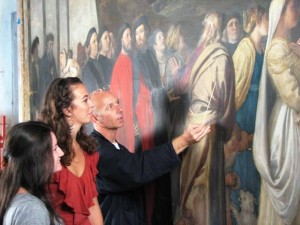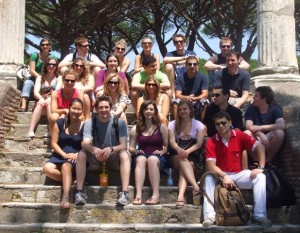With the launch of the new interdisciplinary minor in Italian studies this fall, students on College Hill can make la dolce vita a part of their formal education.
Lafayette students have held a longstanding interest in all things Italian. They regularly fill classes focused on Italian history and culture, and the short-term programs to Florence and Rome are among the most popular study abroad options. So, it made sense to offer a formal track of study to enhance the breadth of students’ understanding of Italian culture.

Megan Cassidy ’12 and Katie O’Neall ’12 watch a restorer work on Titian’s Presentation of the Virgin. They spent a summer interning with the Save Venice organization through a Lafayette program funded by Mary Kolarek Frank ’79.
The minor, which consists of three core courses and three electives, focuses on the several major cultural traditions of the Mediterranean world—the Greco-Roman, Judaeo-Christian, and Islamic traditions—that were inherited and refashioned by Italians of the medieval, Renaissance, and modern eras. Another focus is modern Italy’s role in the European Union and the challenges of economic and political integration, Third World immigration, and other complex issues that Italy faces in common with other European Union nations.
Visit the Italian studies website
“Italy is a fun and stimulating place to visit,” says Anthony Cummings, professor of music and coordinator of the Italian studies program. “The history and richness of the culture make it a popular place to visit. Also, there are a lot of different vectors intersecting to make this a very interesting time in Italy’s history: the economic crisis with Italy, Greece, and Spain; the Italian prime minister, Mario Monti, a fascinating figure; the questions of whether Italy will remain a member of the European Union; and just a great many really urgent, vital questions.”
The minor program will truly be an interdisciplinary course of study. Students who wish to study the Italian language can do that through three courses at the College and three in Rome. But the program is much more than language. It will encompass painting, sculpture, architecture, literature, music, political theory, philosophy, and theology.
Cummings explains that students who understand Christian imagery will be better able to interpret medieval and Renaissance Italian painting, and those with an interest in the visual arts of Italy will be encouraged to study Christian traditions. Similarly, students with an interest in Niccolò Machiavelli’s political theory will benefit from an understanding of his indebtedness to ancient Roman models, such as Livy’s history.
Since Lafayette has the faculty expertise and course work already in place, creating the minor was a relatively easy endeavor. It was just a matter of fitting all the pieces of the puzzle together to create a coherent program, says Cummings.
For instance, Cummings spent last fall as the Robert Lehman Visiting Professor in Residence at Villa I Tatti, The Harvard University Center for Italian Renaissance Studies in Florence, and last spring as scholar in residence at the American Academy in Rome. Cummings also has been named to the Harvard Center’s Council, an international advisory group. He recently published The Lion’s Ear: Pope Leo X, the Renaissance Papacy, and Music (University of Michigan Press, 2012).
EXCEL Scholar Zachary Jones ’13 (Bethlehem, Pa.), a double major in music and anthropology & sociology, will be a co-author of Cummings’ forthcoming book on Italian music from publisher Accademia Nazionale di Santa Cecilia, tentatively titled Delightful Madrigals of Antonio Molino, Newly-Composed…and Brought to Light…1568. Other co-authors include Linda L. Carroll of Tulane University and Marina Toffetti of the University of Padua.
Diane Cole Ahl, Arthur J. ’55 and Barbara S. Rothkopf Professor of Art History, is spending part of this year in Italy; in the fall, she will be the James S. Ackerman Scholar in Residence for one month at the American Academy and in the spring, she will be visiting scholar for one month at the Kunsthistorisches Institut (Art History Institute) in Florence. Ahl is completing The History of Fifteenth-Century Painting in Italy, to be published as part of the Yale University Press Pelican History of Art series. It will be the only book in the series on painting in 15th century Italy.

Students explore Rome through the annual summer course offered by the Lehigh Valley Association of Independent Colleges and administered by Lafayette.
Ahl and Rado Pribic, Williams Professor of Foreign Languages and Literatures and co-chair of international affairs, lead the short-term study abroad course Florence: Birthplace of the Renaissance to Italy every other year. Markus Dubischar, associate professor and assistant head of foreign languages and literatures and chair of the classical civilization studies program, leads the short-term study abroad course Rome the Eternal City: Approaches and Explorations. In addition, George Rosa, professor of foreign languages and literatures, administers the yearly summer course in Rome offered by the Lehigh Valley Association of Independent Colleges. Students may also work with the Office of International and Off-Campus Education to explore other study abroad opportunities. Italian native Gisella Gisolo has been appointed director of that office.
Lafayette recently became a member institution of the American Academy, with Cummings, Ahl, and Dubischar making up the College’s delegation.
Also, through internships funded by Mary Kolarek Frank ’79 and her husband, Howard, students work with Save Venice, Inc., assisting with the restoration of priceless works of art for two months in the summer in Venice, Italy. Art graduate Erica Kamin ’11 and art and economics graduate Lauren Novotny ’11 were the first Lafayette students to travel to Italy for the Save Venice program. Last summer, art graduate Megan Cassidy ’12 and art and economics graduate Katharine O’Neall ’12 participated in Save Venice. Cassidy and O’Neall also spent a semester in Florence living with host families – good preparation for the Save Venice experience, where they were on their own to “live like Italian locals,” according to O’Neall.

